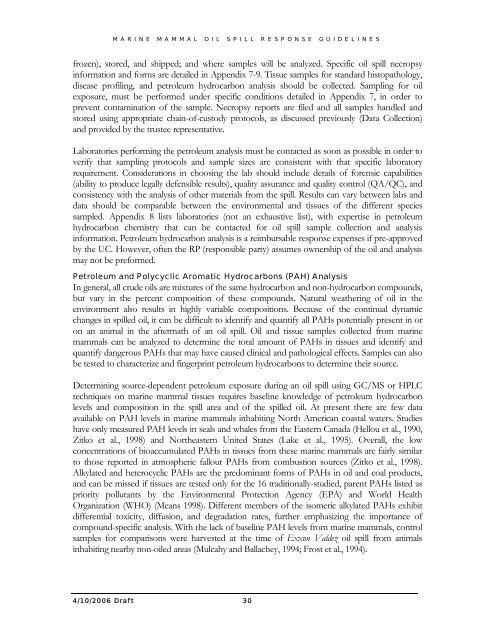Volume III, Appendices EM - National Marine Fisheries Service ...
Volume III, Appendices EM - National Marine Fisheries Service ...
Volume III, Appendices EM - National Marine Fisheries Service ...
You also want an ePaper? Increase the reach of your titles
YUMPU automatically turns print PDFs into web optimized ePapers that Google loves.
MARINE MAMMAL OIL SPILL RESPONSE GUIDELINES<br />
frozen), stored, and shipped; and where samples will be analyzed. Specific oil spill necropsy<br />
information and forms are detailed in Appendix 7-9. Tissue samples for standard histopathology,<br />
disease profiling, and petroleum hydrocarbon analysis should be collected. Sampling for oil<br />
exposure, must be performed under specific conditions detailed in Appendix 7, in order to<br />
prevent contamination of the sample. Necropsy reports are filed and all samples handled and<br />
stored using appropriate chain-of-custody protocols, as discussed previously (Data Collection)<br />
and provided by the trustee representative.<br />
Laboratories performing the petroleum analysis must be contacted as soon as possible in order to<br />
verify that sampling protocols and sample sizes are consistent with that specific laboratory<br />
requirement. Considerations in choosing the lab should include details of forensic capabilities<br />
(ability to produce legally defensible results), quality assurance and quality control (QA/QC), and<br />
consistency with the analysis of other materials from the spill. Results can vary between labs and<br />
data should be comparable between the environmental and tissues of the different species<br />
sampled. Appendix 8 lists laboratories (not an exhaustive list), with expertise in petroleum<br />
hydrocarbon chemistry that can be contacted for oil spill sample collection and analysis<br />
information. Petroleum hydrocarbon analysis is a reimbursable response expenses if pre-approved<br />
by the UC. However, often the RP (responsible party) assumes ownership of the oil and analysis<br />
may not be preformed.<br />
Petroleum and Polycyclic Aromatic Hydrocarbons (PAH) Analysis<br />
In general, all crude oils are mixtures of the same hydrocarbon and non-hydrocarbon compounds,<br />
but vary in the percent composition of these compounds. Natural weathering of oil in the<br />
environment also results in highly variable compositions. Because of the continual dynamic<br />
changes in spilled oil, it can be difficult to identify and quantify all PAHs potentially present in or<br />
on an animal in the aftermath of an oil spill. Oil and tissue samples collected from marine<br />
mammals can be analyzed to determine the total amount of PAHs in tissues and identify and<br />
quantify dangerous PAHs that may have caused clinical and pathological effects. Samples can also<br />
be tested to characterize and fingerprint petroleum hydrocarbons to determine their source.<br />
Determining source-dependent petroleum exposure during an oil spill using GC/MS or HPLC<br />
techniques on marine mammal tissues requires baseline knowledge of petroleum hydrocarbon<br />
levels and composition in the spill area and of the spilled oil. At present there are few data<br />
available on PAH levels in marine mammals inhabiting North American coastal waters. Studies<br />
have only measured PAH levels in seals and whales from the Eastern Canada (Hellou et al., 1990,<br />
Zitko et al., 1998) and Northeastern United States (Lake et al., 1995). Overall, the low<br />
concentrations of bioaccumulated PAHs in tissues from these marine mammals are fairly similar<br />
to those reported in atmospheric fallout PAHs from combustion sources (Zitko et al., 1998).<br />
Alkylated and heterocyclic PAHs are the predominant forms of PAHs in oil and coal products,<br />
and can be missed if tissues are tested only for the 16 traditionally-studied, parent PAHs listed as<br />
priority pollutants by the Environmental Protection Agency (EPA) and World Health<br />
Organization (WHO) (Means 1998). Different members of the isomeric alkylated PAHs exhibit<br />
differential toxicity, diffusion, and degradation rates, further emphasizing the importance of<br />
compound-specific analysis. With the lack of baseline PAH levels from marine mammals, control<br />
samples for comparisons were harvested at the time of Exxon Valdez oil spill from animals<br />
inhabiting nearby non-oiled areas (Mulcahy and Ballachey, 1994; Frost et al., 1994).<br />
4/10/2006 Draf t 30
















